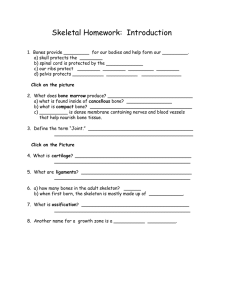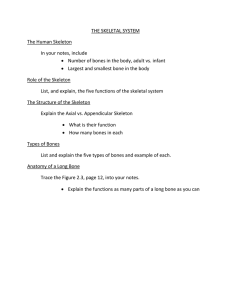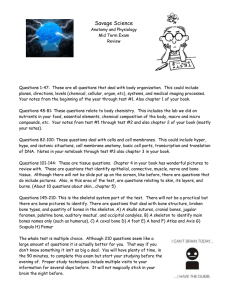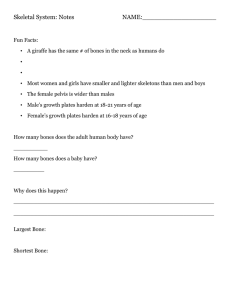S KELETAL UNIT BONE INTRODUCTION NOTES MMHS Anatomy and Physiology
advertisement
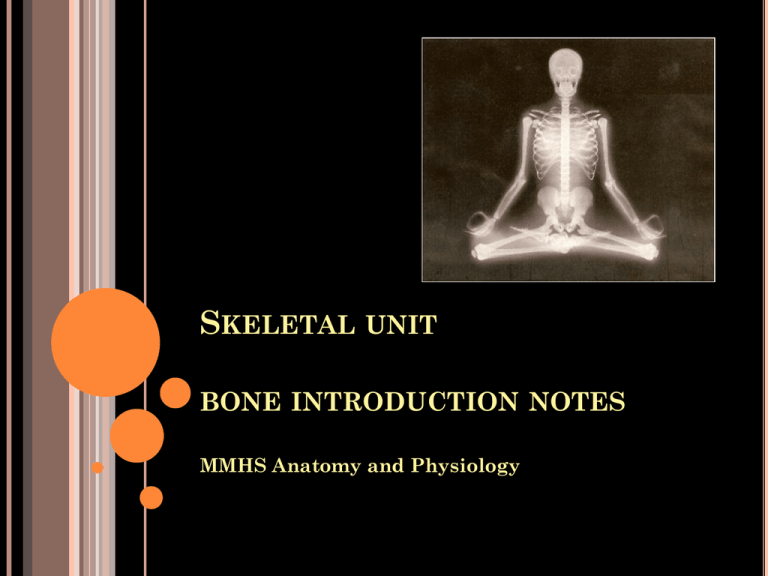
SKELETAL UNIT BONE INTRODUCTION NOTES MMHS Anatomy and Physiology SKELETON DESIGN Human Skeleton has 206 Bones. Humans have endoskeletons (=internal) Arthropods have exoskeletons (=external) Humans must rely on nervous system and sensory organs for protection *oncoming car *hot stove SKELETAL DIVISIONS 2 Main Divisions of the Skeleton 1. 2. Axial skeleton (body’s central frame) Appendicular skeleton (body’s lateral frame) Axial (forms the midline of the body) Includes the following parts cranium, rib cage, vertebral column, sacrum, coccyx Appendicular (think “appendages”) Includes the following parts pectoral girdle (shoulder), pelvic girdle (hips), arms to hands, legs to feet. AXIAL VS APPENDICULAR SKELETON FUNCTION OF SKELETON 1. [Protection] of vital internal organs a) b) c) 2. 3. 4. 5. Skull Rib cage Pelvis protects protects protects brain. heart and lungs reproductive organs. [Support] provides framework for tissues to hang on. [Movement] muscles attached via tendons. [Storage] of minerals like calcium (Ca) and phosphorous (P) [Production] of Erythrocytes (RBC’s) from red marrow. BONE CLASSIFICATION BY SHAPE Bone Shape Location in Body 1. Long Bones Femur, humerus, tibia, fibula 2. Short Bones Carpals and tarsal 3. Flat Bones Clavicle, ribs, cranial plates, scapula 4. Irregular Bones Vertebrae BONE CLASSIFICATION a. long b. irregular c. flat d. irregular e. short BONE ANATOMY 1. 2. 3. 4. Epiphysis = ends of bone (covered in hyaline cart) Epiphyses form RBC’s Diaphysis = narrow shaft of bone Periosteum = layer of connective tissue outside of bone. Contains blood vessels and nerves. Medullary Cavity = Hollow center of the bone. Contains major blood vessels and marrow. ANATOMY OF BONE COMPACT BONE 1. Calcified matrix ( Canaliculi lacunae which hold osteocytes. 2. Osteocytes are connected to each other by canaliculi. 3. ) contain Receive nutrients Get rid of wastes Blood vessels and nerves that travel the length of the bone do so through Haversian Canals. CANCELLOUS “SPONGY” BONE 1. Trabeculae (interconnecting rods of bone) create the “spongy” appearance. 2. Located in epiphyses of bones (close to joints) a) b) Joints bear greater amounts of stress from many directions. Cancellous bone channels stress into direction of compact bone (= more strength) CANCELLOUS BONE GENDER DIFFERENCES IN SKELETONS Male skeletons tend to be heavier to bear greater muscle attachment. Coxa bones (hips) are narrower and more upright Female skeletons have fewer markings on the skeleton Female skeletons are better designed for childbirth. 1. 2. 3. Enlarged pelvic outlet / inlet Less curvature of the sacrum and coccyx. Broader = Iliac bones stick out more laterally but not as high as in males. MALE VS FEMALE
